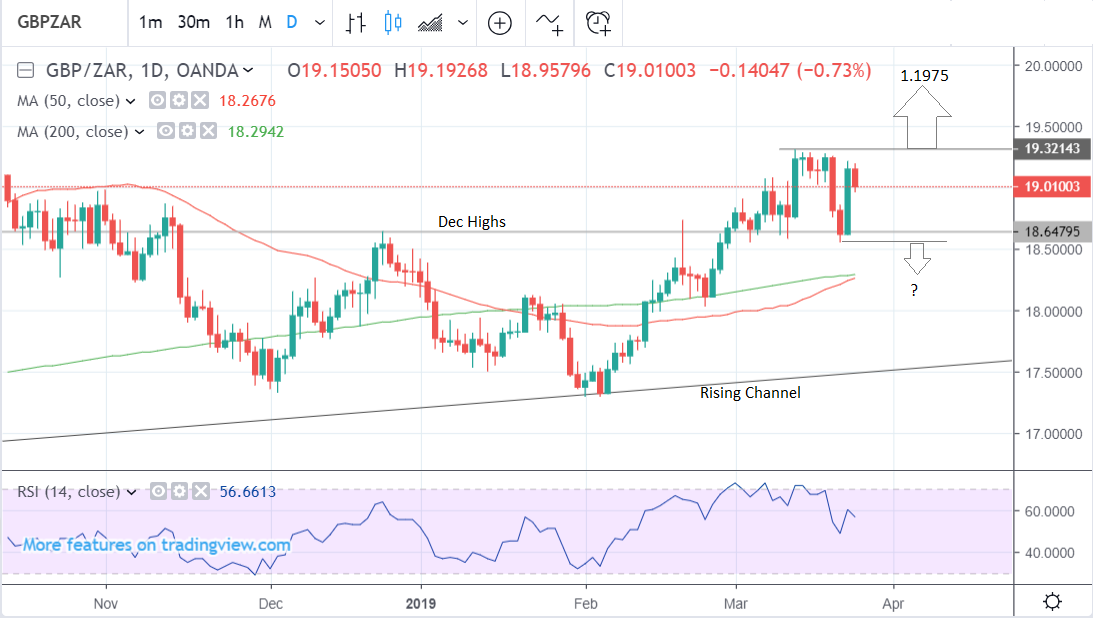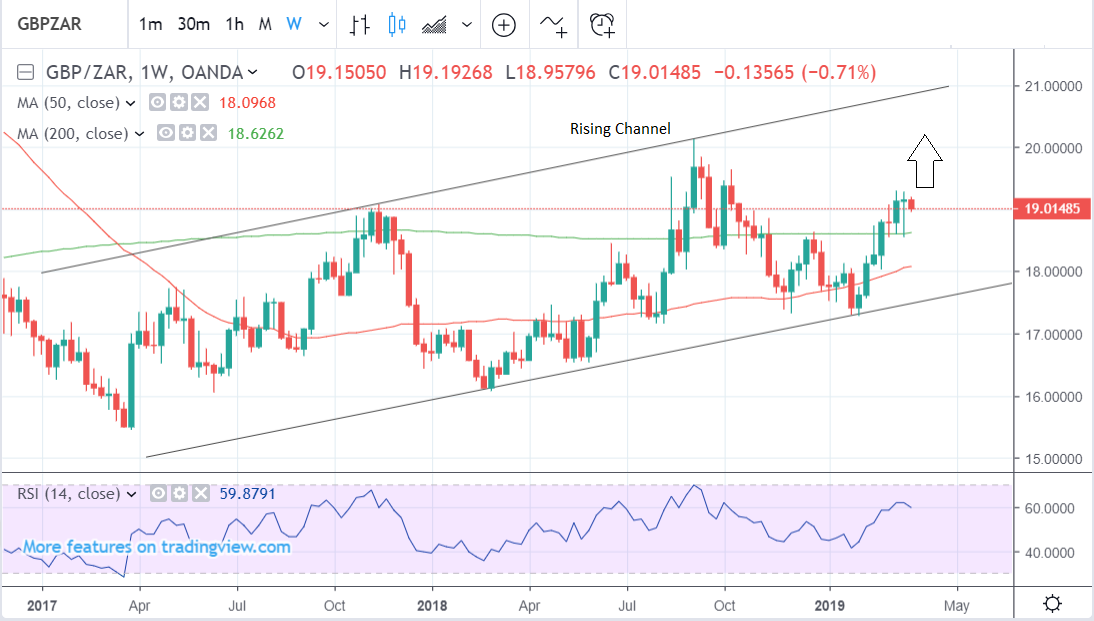The Pound-to-South-African-Rand Rate in the Week Ahead: Further Gains are Ahead

© Adobe Stock
- Rising channel provides GBP/ZAR bullish bias
- Break above recent high would see trend continue
- GBP eyes Brexit news as ZAR looks to Moody’s
The Pound-to-Rand rate was trading around 19.00 on Monday, up a fraction from its Friday close, and studies of the charts suggest there is scope for the market to go on trending higher over the coming day.
The GBP/ZAR pair fell at the start of last week after it the government requested from Brussels only a very short delay to the Brexit process.
However, it later recovered some of its loss after the EU left the door open to a much longer extension of the Article 50 negotiating window, and potentially an indefinite one if Prime Minister Theresa May fails again to get the EU Withdrawal Agreement through parliament.
Pundits are still suggesting she will struggle to win enough votes for her deal to be approved next week so there is at least one fundamental reason for why the Pound could rise during the week ahead as a third failure of the Withdrawal Bill to clear parliament might see the market fixate on the odds of Brexit being abandoned by the government or prevented through a second referendum.

Above: Pound-to-Rand rate shown at daily intervals.
From a technical perspective, the outlook for the exchange rate is bullish, although only marginally. The pair remains in a short-term uptrend and the early-March break above the high scored back in December is a bullish factor.
If the market is able to rise above the 19.30 level that stopped its advance on March 13 then a more protracted move up to 19.75 could be in prospect. Alternatively, a break below the 18.55 low seen last week would open the door for a reversal of the uptrend. We favour the bullish scenario given that is consistent with the prevailing trend.

Above: Pound-to-Rand rate shown at weekly intervals.
AA
The Rand: What to Watch
There are several important events for the Rand in the week ahead including the March meeting of the South African Reserve Bank (SARB) on Wednesday at 13:00 London time and Moody’s rating decision that is due out after the market close on Friday, 29 March.
The Moody’s rating decision is the most important and a risk to the Rand because it could decide to downgrade South Africa (SA) to 'junk' status, which will mean many international investors are forced to sell their South African government bond holdings.
This would lead to large outflows from the Rand and would also be disastrous for future investment into South Africa.
SA has been teetering on the edge of a Moody's downgrade for several years. The other two other major ratings agencies, S&P and Fitch, have already cut South Africa's rating below the investment grade threshold.
“On the face of it, it would seem that our fate is sealed, especially if we consider February’s budget outcomes and Eskom’s apparent unraveling, yet there are indications that the agency is more forgiving of our shortcomings and might grant SA a reprieve, at least in the short term, to allow structural reforms to take hold,” says Nema Ramkhelawan-Bhana, an economist at Rand Merchant Bank. "What’s clear is that the market is coloured with ambiguity, which should translate into thinner flows, particularly into SA’s local bond market."
After a brief period of optimism following Cyril Ramaphosa’s replacement of Jacob Zuma as president in early 2018, hopes of quick reform and progress have waned and the threat of a downgrade once again looms large over South Africa.
The financial problems for the state power utility Eskom are a major source of concern for rating agencies. Last week the country underwent several 12hr power cuts due to Eskom’s difficulties with power generation, which could impact on growth.
One recent positive piece of news for South Africa is the discovery of huge reserves of natural gas of the coast, which could evetnually help cover the country’s energy needs, in addition to reducing the trade deficit and lifting economic growth.
“We believe that rand weakness induced by SA-specific events, such as power cuts, the pending much awaited ratings review by Moody’s this Friday as well as national elections in May, should fade. Therefore, we see the SARB keeping rates steady this year. We expect Moody’s to keep SA’s sovereign rating unchanged, at investment grade,” says Shireen Darmalingam, an analyst at Standard Bank.
The Bloomberg consensus for this week's SARB meeting is for the Bank to leave its interest rate unchanged at 6.75% in March. The market does however, expect a rate cut later in the year, but not before the Moody's rating decision is known.
Not all analysts are as optimistic as Standard Bank's Darmalingam. Rand Merchant Bank's Ramkhelawan-Bhana says risks for the Rand are tilted to the downside this week.
“With the SARB likely to express a more dovish stance as it keeps interest rates on hold, given a widening output gap and an easing in global financial conditions. The MPC might be more inclined to consider an interest rate cut if inflation expectations continue to respond to the committee’s persistent focus on the mid-point of the inflation target but that is a conversation for Thursday, “ Ramkhelawan-Bhana writes, in a note to clients Monday.
AA
The Pound: What to Watch
The main event for the Pound in the week ahead will be the third parliamentary vote on the government’s EU Withdrawal Agreement, although an exact date is yet to be set.
If Parliamentarians support the bill the UK will leave the EU on May 22 under the Withdrawal Agreement. But if MPs reject it then there the government has said it will offer a series of "indicative votes" to MPs, giving Parliament an opportunity to express its desired course.
At that point there will still be a risk that the UK leaves the EU without a deal and the key date in focus will be April 12, although this could change the moment the EU agrees to a further extension, if and when it does.
If Parliament was succesful in foisting another referendum or a general on the electorate, another much longer extension is sure to be required, alongside participation in the EU parliamentary elections.
However, and alternatively, if Parliament was to back the idea of a customs union with the EU or some other model of post-Brexit relationship it's possible that no further extension would be required as the details of such a relationship would be thrashed out in the second stage of the negotiations.
But the government must notify the EU of the path it intends to take before April 12.
“Leaving on April 12 without a deal is now the default path, and while that will most probably be avoided at the end, the mere fact this massive risk still lurks in the background is likely enough to keep sterling under pressure for now,” says XM's Hadjikyriacos.
On the data front, the next key release for the Pound is the final estimate for final quarter GDP growth, due out at 09:30 on Friday. Consensus is for growth to be confirmed at 0.2% for the final quarter and 1.4% for 2018 as a whole.
Time to move your money? Get 3-5% more currency than your bank would offer by using the services of foreign exchange specialists at RationalFX. A specialist broker can deliver you an exchange rate closer to the real market rate, thereby saving you substantial quantities of currency. Find out more here.
* Advertisement




